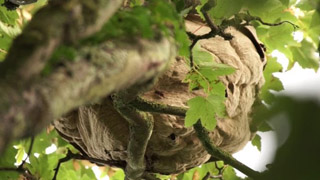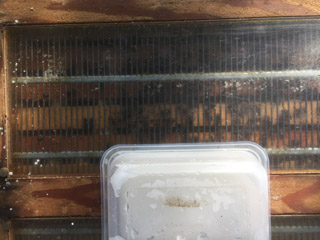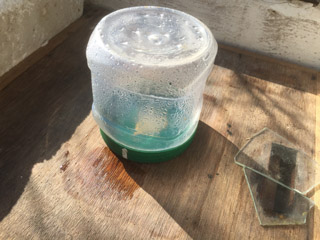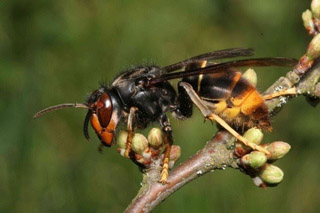 This weather we’re experiencing at the moment, whilst very welcome and so heraldic of Spring, should not persuade us to drop our guard as far as Winter is concerned. This time last year we had a similar cycle of events – pleasant, warm weather in late January and early February – but this was followed by the Beast from the East towards the end of February and into March. This took us all by surprise, none more so than our poor bees.
This weather we’re experiencing at the moment, whilst very welcome and so heraldic of Spring, should not persuade us to drop our guard as far as Winter is concerned. This time last year we had a similar cycle of events – pleasant, warm weather in late January and early February – but this was followed by the Beast from the East towards the end of February and into March. This took us all by surprise, none more so than our poor bees.
They had started growing their colonies a lot earlier than usual because of the mild weather and consequently had a larger amount of brood to feed and keep warm. The cold winds and snow at the end of February resulted in a lot of that brood dying because there weren’t enough adult bees to cover it up and keep it warm. This was because the adult bees themselves had to cluster tightly to survive and to keep their queen alive.
 In many cases they had to cluster so tightly that they were unable to move once they had eaten the stores they were in contact with and subsequently died of starvation, even though there were plenty of stores immediately next to them and throughout the rest of the hive. This is called “isolation starvation” and is perhaps one of the most common reasons for colony deaths during the late Winter/early Spring months. I can’t normally relax as far as bees’ feed is concerned until the blackthorn comes into flower. I then breathe a sigh of relief and life can carry on as normal.
In many cases they had to cluster so tightly that they were unable to move once they had eaten the stores they were in contact with and subsequently died of starvation, even though there were plenty of stores immediately next to them and throughout the rest of the hive. This is called “isolation starvation” and is perhaps one of the most common reasons for colony deaths during the late Winter/early Spring months. I can’t normally relax as far as bees’ feed is concerned until the blackthorn comes into flower. I then breathe a sigh of relief and life can carry on as normal.
As a result of having lost several colonies myself last year, I modified my approach to feeding this year and when placing sugar fondant on the hives, where there was room, I placed it in contact with the bees, laying it on the top bars of the brood frames, rather than over the feed-hole on the crown board (the hive “ceiling”). This means the bees would not have to move to be able to get a mouthful of sugar to replenish their energy and warmth levels, so would be able to stay in cluster and still have food available to them.
 It’s worked so far (but then we haven’t yet had any really protracted cold spells – yet!). However, I have now reached a point where I am replacing any empty fondant containers with what are called “contact feeders”. These allow a very limited access to a very dilute liquid sugar syrup. I have never done this before, but because of the way the colonies shrank last year after the cold snap I want to try and build them up more rapidly this year than they perhaps otherwise would be able to do if they relied purely on availability of nectar in flowering plants.
It’s worked so far (but then we haven’t yet had any really protracted cold spells – yet!). However, I have now reached a point where I am replacing any empty fondant containers with what are called “contact feeders”. These allow a very limited access to a very dilute liquid sugar syrup. I have never done this before, but because of the way the colonies shrank last year after the cold snap I want to try and build them up more rapidly this year than they perhaps otherwise would be able to do if they relied purely on availability of nectar in flowering plants.
The very dilute syrup is akin to nectar in flowers and “cons” the bees into thinking there is a nectar flow on and in processing that “nectar” they chivvy the queen to lay more eggs than she might otherwise do. Obviously, if the weather turns, I will have to switch back to fondant again – but sometimes these gambles pay off!
 The bees have been very active over the past few weeks, flying quite strongly on the warmer, sunnier days. Looking into the brood boxes through the Perspex or glass crown boards, I can see most of my colonies are already very strong for this time of year. This implies the queen has been busy laying eggs throughout the Winter, whereas she would normally slow down quite dramatically during this time. This has resulted in more bees being born than usual which more than makes up for the number that die naturally of old age during the winter months, resulting in expanding colonies. I am just hoping that the weather continues mild to give them a chance of survival.
The bees have been very active over the past few weeks, flying quite strongly on the warmer, sunnier days. Looking into the brood boxes through the Perspex or glass crown boards, I can see most of my colonies are already very strong for this time of year. This implies the queen has been busy laying eggs throughout the Winter, whereas she would normally slow down quite dramatically during this time. This has resulted in more bees being born than usual which more than makes up for the number that die naturally of old age during the winter months, resulting in expanding colonies. I am just hoping that the weather continues mild to give them a chance of survival.
 Talking of survival, honey bees propagate their species by swarming and it will soon be the start of the swarming season (normally no earlier than March but generally from April onwards). Over the past two weeks I have been gathering names of beekeepers across the county who are willing to collect swarms once reported. When all the names are in, I will create a list and distribute it to interested parties (Cornwall Council, the police, fire brigade, pest controllers, beekeeping supplies businesses as well as on our Cornwall Beekeepers’ website and the British Beekeepers’ website). I will report back here once that task is finished.
Talking of survival, honey bees propagate their species by swarming and it will soon be the start of the swarming season (normally no earlier than March but generally from April onwards). Over the past two weeks I have been gathering names of beekeepers across the county who are willing to collect swarms once reported. When all the names are in, I will create a list and distribute it to interested parties (Cornwall Council, the police, fire brigade, pest controllers, beekeeping supplies businesses as well as on our Cornwall Beekeepers’ website and the British Beekeepers’ website). I will report back here once that task is finished.
 Again, talking about survival, the dreaded Asian Hornet queens will be emerging from hibernation round about now. They will be looking for food that gives them energy, viz something sweet, so I am placing Asian Hornet traps in my apiary primed with a sweet bait of beer and sugar. The idea of trapping the queens (apart from preventing them from building their nests, of course!) is to identify their presence, as they were found in Fowey and Liskeard last year and might come a little further south west this year.
Again, talking about survival, the dreaded Asian Hornet queens will be emerging from hibernation round about now. They will be looking for food that gives them energy, viz something sweet, so I am placing Asian Hornet traps in my apiary primed with a sweet bait of beer and sugar. The idea of trapping the queens (apart from preventing them from building their nests, of course!) is to identify their presence, as they were found in Fowey and Liskeard last year and might come a little further south west this year.
I have made the trap I referred to last month and I also have a commercially produced version but if you would like to make one yourself, using an old lemonade bottle then the plans can be found by searching “Asian Hornet trap” on the web and looking at the .pdf file at the National Bee Unit download site. Keep a lookout in the meantime and if you see anything suspicious, either insect or embryo nest, get in touch either with myself or with the non-native species secretariat at alert_nonnative@ceh.ac.uk
Colin Rees – 01872 501313 – 07939 971104 – colinbeeman@aol.com
